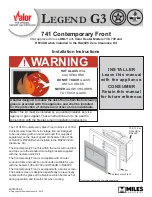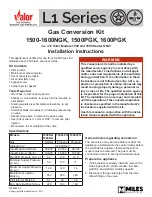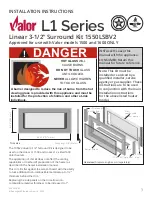
25
2.
Lift the ash dump plug at the left of the firebox by hooking the poker through the loop on the
cover and lifting up.
3.
Push the ashes through the hole and leave some ashes to cover the ash dump plug once it is
replaced. Leave an ash bed of approximately 1” deep on the firebox bottom to help maintain a hot
ember bed.
4.
Clear the ashes from the area where the plug normally sits so that it will properly seat against the
opening edges; tap it down with your poker to ensure proper seating.
5.
Cover the plug with the remaining ashes and continue operation of your stove as usual. The Ash
Drawer is on the LH side and can be removed by pulling it out toward you. Lift the Ash Drawer
slightly or the pedestal base may get scratched. Ashes should be placed in a metal container with
a tightly fitting lid. This closed container should be placed on a non-combustible floor or on the
ground, well away from all combustible materials, pending final disposal. Ensure the rear half of
the lid is open before replacing the Ash Drawer.
If the ashes are disposed of by burial in soil or otherwise locally dispersed, they should be retained
in the closed container until all cinders have thoroughly cooled. Do not place other waste materials
in the metal ash container. If bright embers are glowing above the ash dump port during a low or
medium low fire, air may be leaking past the ash plug. If this is happening, a possible over fire
hazard exists. The stove should be shut down and allowed to cool. Properly seal the ash dump
plug to the stove.
3.3 Chimney
Cleaning
Regular chimney maintenance, as well as good burning practices, are required to prevent chimney fires.
The chimney and the chimney connector pipe must be maintained in good condition and be kept clean in
order to be safe. This means that the chimney should be checked regularly for creosote build-up.
Inspection and cleaning of the chimney is facilitated by a removable baffle.
C
AUTION
:
O
PERATION
O
F
Y
OUR
O
SBURN
2400
W
ITHOUT
T
HE
B
AFFLE
M
AY
C
AUSE
U
NSAFE
A
ND
H
AZARDOUS
T
EMPERATURE
C
ONDITIONS
A
ND
W
ILL
V
OID
T
HE
W
ARRANTY
.
Contact your local, municipal, state, or provincial fire authority for information on how to handle a
chimney fire before there is any chance that it may happen.
When wood (especially green wood) is burned without adequate heat or air supply, it produces tar and
other organic vapours (
smoke
), which combine with expelled moisture to form creosote.
The creosote vapours condense in the relatively cool chimney flue of a slow-burning fire. As a result,
creosote residue accumulates on the flue lining. When ignited, this creosote makes an extremely hot fire
which could be hazardous. Check frequently for creosote build-up. In the event of a stove or chimney
component failure, replace only with equipment that is equivalent to the original, available from your








































